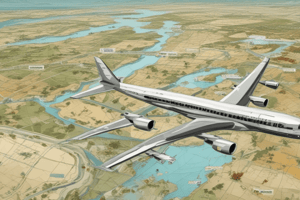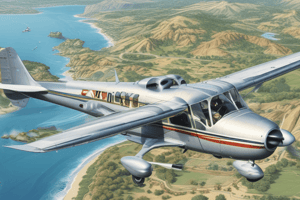Podcast
Questions and Answers
What does the white dot represent on the airport symbol if Cairns Army Airfield has an open dot on the airport symbol?
What does the white dot represent on the airport symbol if Cairns Army Airfield has an open dot on the airport symbol?
Location of NAVAID supporting the airfield
How do you know if services are available at an airport?
How do you know if services are available at an airport?
Tick marks around the airport symbol
What are the Class B Airspace VFR Weather minimums?
What are the Class B Airspace VFR Weather minimums?
3SM Vis, Clear of Clouds
What are the Class E Airspace VFR Weather minimums less than 10,000 ft MSL?
What are the Class E Airspace VFR Weather minimums less than 10,000 ft MSL?
What are the Class E Airspace VFR Weather minimums at or above 10,000 ft MSL?
What are the Class E Airspace VFR Weather minimums at or above 10,000 ft MSL?
What are the Class G Airspace VFR Weather minimums 1,200 ft or less above surface?
What are the Class G Airspace VFR Weather minimums 1,200 ft or less above surface?
What are the Class G Airspace VFR Weather minimums more than 1,200 ft above surface but less than 10,000 ft MSL?
What are the Class G Airspace VFR Weather minimums more than 1,200 ft above surface but less than 10,000 ft MSL?
What are the Class G Airspace VFR Weather minimums more than 1,200 ft above surface at or above 10,000 ft MSL?
What are the Class G Airspace VFR Weather minimums more than 1,200 ft above surface at or above 10,000 ft MSL?
How long can you go without oxygen at 10,000 ft?
How long can you go without oxygen at 10,000 ft?
When is oxygen required for all flight?
When is oxygen required for all flight?
What does a star with a circle in the middle of it (open star) on a map mean?
What does a star with a circle in the middle of it (open star) on a map mean?
Airports with control towers are shown in ______
Airports with control towers are shown in ______
What are the dimensions of Class A Airspace?
What are the dimensions of Class A Airspace?
Unless otherwise authorized, all persons operating in Class A airspace must operate their aircraft under _____.
Unless otherwise authorized, all persons operating in Class A airspace must operate their aircraft under _____.
How is Class B depicted?
How is Class B depicted?
What are the vertical and lateral dimensions of Class B?
What are the vertical and lateral dimensions of Class B?
Class B Airspace has what kind of veil and what is it for?
Class B Airspace has what kind of veil and what is it for?
What does every Class B airport come with?
What does every Class B airport come with?
What is the TAC's scale?
What is the TAC's scale?
How is class C airspace depicted?
How is class C airspace depicted?
What are the lateral dimensions for Class C airspace?
What are the lateral dimensions for Class C airspace?
When should you begin calling ATC when coming to a Class C airspace?
When should you begin calling ATC when coming to a Class C airspace?
What are the vertical dimensions of Class D airspace?
What are the vertical dimensions of Class D airspace?
What does a magenta segmented line mean?
What does a magenta segmented line mean?
How is a restricted area designated?
How is a restricted area designated?
Flashcards
Location of NAVAID
Location of NAVAID
Cairns Army Airfield has an open dot on the airport symbol, representing a NAVAID location.
Services available at airport
Services available at airport
Tick marks around airport symbol indicate available services at that airport.
Class B Airspace VFR Weather
Class B Airspace VFR Weather
3SM visibility, clear of clouds is required for VFR in Class B airspace.
Class C Airspace VFR Weather
Class C Airspace VFR Weather
Signup and view all the flashcards
Class D Airspace VFR Weather
Class D Airspace VFR Weather
Signup and view all the flashcards
Class E Airspace VFR Weather (below 10,000 ft)
Class E Airspace VFR Weather (below 10,000 ft)
Signup and view all the flashcards
Class E Airspace VFR Weather (at or above 10,000 ft)
Class E Airspace VFR Weather (at or above 10,000 ft)
Signup and view all the flashcards
Class G Airspace VFR Weather (1,200 ft or less)
Class G Airspace VFR Weather (1,200 ft or less)
Signup and view all the flashcards
Class G Airspace VFR Weather (over 1,200 ft)
Class G Airspace VFR Weather (over 1,200 ft)
Signup and view all the flashcards
Class A Airspace dimensions
Class A Airspace dimensions
Signup and view all the flashcards
Operating in Class A Airspace
Operating in Class A Airspace
Signup and view all the flashcards
Class B Airspace depiction
Class B Airspace depiction
Signup and view all the flashcards
Class B operating requirements
Class B operating requirements
Signup and view all the flashcards
Class C Airspace depiction
Class C Airspace depiction
Signup and view all the flashcards
Class C Airspace lateral dimensions
Class C Airspace lateral dimensions
Signup and view all the flashcards
Class C Airspace vertical dimensions
Class C Airspace vertical dimensions
Signup and view all the flashcards
Entering Class C Airspace requirements
Entering Class C Airspace requirements
Signup and view all the flashcards
Class D Airspace depiction
Class D Airspace depiction
Signup and view all the flashcards
Class E airspace start indications
Class E airspace start indications
Signup and view all the flashcards
Alert Area purpose
Alert Area purpose
Signup and view all the flashcards
Magnetic North definition
Magnetic North definition
Signup and view all the flashcards
True Heading (TH)
True Heading (TH)
Signup and view all the flashcards
Agonic Line
Agonic Line
Signup and view all the flashcards
True Airspeed (TAS)
True Airspeed (TAS)
Signup and view all the flashcards
Ground Speed (GS)
Ground Speed (GS)
Signup and view all the flashcards
VFR minimums for helicopters
VFR minimums for helicopters
Signup and view all the flashcards
TFR Purpose
TFR Purpose
Signup and view all the flashcards
Study Notes
VFR Navigation Test Flashcards - Study Notes
-
NAVAID Location:
- An open dot on an airport symbol indicates the location of a NAVAID supporting the airfield.
-
Airport Services:
- Tick marks around an airport symbol indicate available services.
-
Class B Airspace VFR Weather Minimums:
- 3SM visibility
- 1000 ft above
- 500 ft below
- 2000 ft horizontal
-
Class C Airspace VFR Weather Minimums:
- Same minimums as Class B.
-
Class D Airspace VFR Weather Minimums:
- Same minimums as Class B and C.
-
Class E Airspace (Below 10,000 ft MSL) VFR Weather Minimums:
- 3SM visibility
- 1000 ft above
- 500 ft below
- 2000 ft horizontal
-
Class E Airspace (Above 10,000 ft MSL) VFR Weather Minimums:
- 5SM visibility
- 1000 ft above
- 1000 ft below
- 1SM horizontal
-
Class G Airspace (1,200 ft or Less AGL) VFR Weather Minimums:
- Day: 1/2 SM visibility, clear of clouds
- Night: 1 SM visibility, clear of clouds
-
Class G Airspace (Above 1,200 ft AGL, Below 10,000 ft MSL) VFR Weather Minimums:
- Day: 1 SM visibility, 1000 ft above, 500 ft below, 2000 ft horizontal
- Night: 3 SM visibility, 1000 ft above, 500 ft below, 2000 ft horizontal
-
Class G Airspace (Above 10,000 ft MSL) VFR Weather Minimums:
- Day and Night: 5SM visibility, 1000 ft above, 1000 ft below, 1SM horizontal
-
Oxygen Requirements:
- 1 hour at 10,000 ft without supplemental oxygen.
- 30 minutes at 12,000 ft without supplemental oxygen.
- Oxygen required for all flights at 14,000 ft and above.
-
Airport Symbols:
- Open star (with circle): Rotating airport beacon in operation (sunset to sunrise).
- Blue: Airports with control towers.
- Magenta: Airports without control towers.
-
Class A Airspace:
- 18,000 ft MSL to FL600 (60,000 ft).
- Overlying waters within 12 NM of the 48 contiguous states and Alaska.
- IFR required.
-
Class B Airspace:
- Depicted as an upside-down 3-tiered cake (3 blue concentric circles).
- Lateral and vertical dimensions vary, detailed on chart.
- Radio communications, ATC clearance and Mode-S transponder mandatory
-
Class B Airspace "Mode C Veil":
- 30 nautical miles outside Class B airports, requires Mode C or S transponder to enter.
-
Class B Airport Equipment:
- Every Class B airport has a Terminal Area Chart (TAC).
-
TAC Scale: 1:250,000 scale to show detail.
-
Class C Airspace:
- Depicted by two magenta concentric circles.
-
Class C Lateral Dimensions:
- Core Surface: 5NM radius.
- Shelf Area: 10NM radius.
-
Class C Vertical Dimensions:
- Core: Surface to 4,000 ft above airport elevation.
- Shelf: 1,200 ft AGL to 4,000 ft above airport elevation.
-
Class C Operating Requirements:
- Two-way radio communication prior to and during operation.
- Mode-S transponder with ADS-B required within and above 10,000 ft MSL.
-
Class C Communications:
- Begin communication 20 NM out
-
Class D Airspace:
- Depicted by blue segmented lines tailored to each airspace. Usually from surface to 2500 ft AGL.
- Two-way radio communication is required prior to and during operation.
- Mode C Transponder required
-
Class E Airspace:
- Depicted with magenta dashed lines or vignettes, varying dimensions dependant on map.
- No operating requirements for below 10000' MSL
- Mode-S transponder with ADS-B required above 10,000 ft MSL.
-
Magenta Segmented Line: Indicates Class E airspace beginning at 700 ft AGL.
-
Magenta Vignette: Class E Airspace begins at an airport without a tower.
-
Blue Vignette: Class E airspace beginning above 1200 feet AGL.
-
Class G Airspace: Generally no restrictions, uncontrolled airspace outside controlled areas.
-
Terminal Radar Service Area (TRSA): Areas where pilots can receive additional radar services. Pilots are encouraged, not required, to participate. Depicted by solid black/grey concentric lines.
-
MOA Participation: Contact radar approach control or controlling agency to use TRSA services.
-
Restricted Area: Special use airspace. Denotes invisible flight hazards (aerial gunnery, etc.). Advance permission required.
-
Restricted Area Depiction: Blue feathered lines with "R" and number designator.
-
Warning Area: Special use airspace. Airspace within 3NM of coastline. Activities may be hazardous for other aircraft.
-
Warning Area Depiction: Blue feathered lines with "W" & number designator.
-
Prohibited Area: Special use airspace. Established for national security. Aircraft prohibited from entering.
-
Prohibited Area Depiction: Blue feathered lines with "P" & number designator.
-
Alert Area: Special use airspace. High-volume pilot training or unusual activity. No restrictions on through flight.
-
Alert Area Depiction: Magenta feathered lines with "A" & number designator.
-
Military Operations Areas (MOAs): Special use airspace for separating military training from IFR traffic.
-
MOA Depiction: Magenta feathered lines with "MOA" & number designator.
-
Air Defense Identification Zone (ADIZ): Airspace for identification & control of aircraft for national security.
-
ADIZ Depiction: Solid magenta line and dots with "Air Defense Identification Zone". VFR aircraft must be on a DVFR flight plan.
-
Temporary Flight Restrictions (TFR): Temporary flight restrictions imposed by the FAA, disseminated by NOTAM.
-
TFR Dimensions: Usually 2,000 ft AGL, 3 NM radius.
-
TFR Reasons: Disaster relief, public safety, sightseeing aircraft, government heads
-
Course Plotting Tick Marks: Every 10NM (Placement) every 20 NM (Label); Every 15 NM (Visual Checkpoints)
-
Maximum Elevation Figure (MEF): Large and small blue numbers in 30′ quadrangles, MSL.
-
National Park Altitude: 2,000 ft AGL.
-
Oxygen at 12,500 ft PA: No (altitude below 14,000 ft).
-
Rotary-Wing Reserve Fuel: 20 minutes at cruise.
-
Destination Weather Validity: 1 hour after estimated time of arrival (ETA).
-
Special VFR (SVR) Minimums: 1/2 SM visibility, clear of clouds (unless higher required).
-
Weather Forecast Void Time: 1 hour 30 minutes.
-
Controlled Airspace VR Minimum Weather: 1000 ft ceiling, 3 SM visibility.
-
Cruising Altitude Rule Commencement: Above 3,000 ft AGL.
-
VR Flight Altitudes (Eastern): Odd +500
-
VR Flight Altitudes (Western): Even +500.
-
CTA Frequencies: Begin monitoring and communicating 10 NM from non-towered airport.
-
Restricted Area VFR Entry: Authorized by the controlling agency.
-
Warning Area Purpose: Alerts non-participating pilots of potential hazards.
-
MOA Procedures: Contact an FSS within 100 miles to obtain updated operation hours, and contact controlling agency.
-
Alert Area Purpose: Informs pilots of high-volume training or unusual activity.
-
TFR Awareness: Check NOTAMS.
-
Disaster Relief TFR: Yes
-
Class G Floor departing Brewton: 1200 ft AGL.
-
Special VFR Clearance: Required for deteriorating weather (700 ft ceiling with 1/2 SM visibility).
-
Isogonic Lines: Lines connecting points of equal magnetic variation.
-
True Course (TC): Angle from true North to flight plan (clockwise).
-
Ground Speed (GS): Aircraft speed over the ground.
-
Agonic Line: Line connecting points of zero degrees magnetic variation.
-
Magnetic North: Angle from magnetic North to aircraft nose (clockwise).
-
True Airspeed (TAS): Calibrated airspeed, corrected for density altitude and temperature.
-
Drift Correction (DC): Correction applied to avoid drifting off course.
-
Variation (VAR): Difference between true and magnetic north.
-
Track (TR): Actual ground path, clockwise from True North.
-
Calibrated Airspeed (CAS): Corrected indicated airspeed for instrument errors.
-
True Heading (TH): Angle from True North to aircraft nose (clockwise).
-
Wind and Heading Effect (010 deg): Wind from 210 deg causes right drift, faster ground speed than TAS.
-
Speed Affected by Wind: Ground Speed (GS).
-
Drift Angle Calculation: Difference between True Heading (TH) and Track (TR).
-
Airport Runway Depiction (Circles): Hard surfaced runways; 1,500-8,069 ft long.
-
Airport Runway Depiction (Non-Circles): Hard surfaced runways > 8,069 ft, or multiple runways < 8,069 ft.
-
Airport Dotted Open Symbol: Indicates the location of airfield NAVAID.
-
Heliport Depiction: H with a circle around it (magenta) on the map.
-
Unverified Airport Depiction: U with a circle around it (magenta) on the map.
-
Abandoned Airport Depiction: X with a circle around it (magenta) on the map.
-
Ultralight Flight Park Depiction: F with a circle around it (magenta) on the map.
Studying That Suits You
Use AI to generate personalized quizzes and flashcards to suit your learning preferences.




